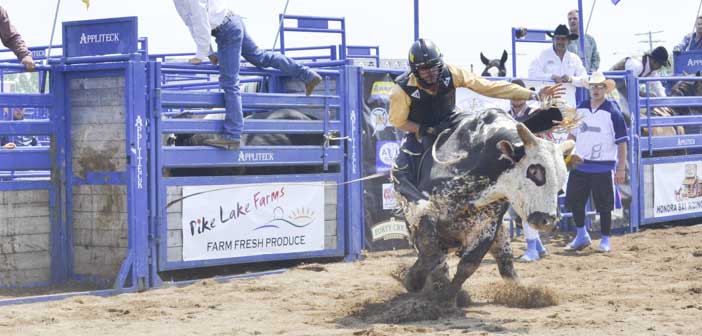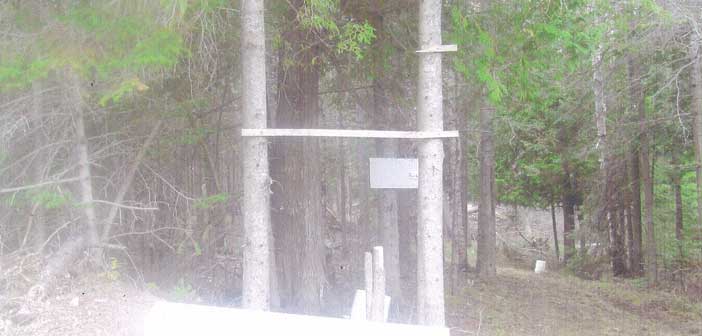This is part two of a series designed to help people understand what rodeo is in a lead up to the Manitoulin Rodeo, coming to the Manitowaning fairgrounds this June 28 and 29.
The Manitoulin Rodeo is gearing up in just one month for cowboys and cowgirls from all over to come to the Manitowaning Fairgrounds once again to compete in a two-day event with lots of activities. We are planning a local horse show with competitors from the Island and all over, as well as our new event—the redneck truck pull. (For more info contact Adam Moggy at 705-859-1125.)
Come and join us Saturday afternoon for a lot of fun, noise and excitement and into the evening as we kick off a party at the arena. Sunday will begin with our children’s rodeo that promises to be bigger and better this year with more events and a great time to be had by all before day two of the Wild Horse Productions rodeo.
As mentioned in part one, there are two types of events: timed and rough stock events. Here are a few more events to look forward to on June 28 and 29.
Breakaway roping: timed event
This is a cowgirls’ event, similar to calf roping. The cowgirl starts from the box and her calf is given a head start while the cowgirl pursues and attempts to loop her rope around the head of the calf as quickly as she can. Unlike calf roping, the cowgirls have no other chances at making up time. If a calf roper is slow to catch the calf he can make up time in bringing it to the ground and tying its legs. The breakaway roper’s time comes only from the catch. If she misses there is no time marked. If she catches the fastest time, she wins. Her rope is attached to the saddle horn and comes free as she makes her catch. A flag attached to the rope is released with the catch and alerts the judge to stop the time.
Team roping: timed event
Team roping is the only rodeo event with two competitors at once: a “header” and a “heeler.” Skill and cooperation and good timing are essential in a successful run. The ropers wait in their boxes on either side of the chute from which the steer is released into the arena. The steer is given a head start by a barrier that is released when the steer is at a pre-determined point. If the header leaves too soon, the barrier is broken resulting in a 10 second penalty. Once the steer is in the arena it is quickly followed by the header and the heeler. The header must rope the steer first around both horns, one horn and the head, or around the neck. He then turns the steer to the left, exposing its hind legs to the pursuing heeler. The heeler then needs precision timing to rope both heels. When the header and the heeler have taken up the slack in their ropes and they have their horses facing each other the clock is stopped. If only one heel is caught the team faces a five second penalty.
Tie down roping: timed event
Tie down roping’s roots can be found on the ranches of working cowboys and the skills are still in use today for catching and immobilizing calves. This can be needed in many cases as beef cattle, especially, roam large areas of pasture land. However, in general, the young stock and in most cases even the older stock are not tame, therefore if one requires veterinary care, treatments, or branding. This is a very practiced skill. In rodeo the calf is given a head start while the roper waits in “the box” behind the barrier. If the roper leaves too soon, breaking the barrier (often referred to as a cowboy speeding ticket), a 10 second penalty is added to the roper’s time. The roper pursues the calf at the speed of up to 30 mph and attempts to throw his loop around the calf’s neck. The roper’s partner (his well-trained horse) plays a key role in achieving a fast roping time. Once the calf is roped the horse comes to a stop and the roper dismounts, sprinting to the calf, the horse will help the roper by taking small backwards steps to keep the slack out of the rope as the cowboy lays the calf down and ties three of its legs in a manner that does not hurt the animal. When the tie is complete, the roper throws his hands in the air to signal “time” and stop the clock. The roper then returns to his horse, mounts, and moves the horse forward to relax the tension on the rope. The timer waits for six seconds, during which the calf must stay tied before an official time is recorded. Top professional calf ropers will rope and tie a calf in seven seconds. The world record is just over six seconds.
Saving the best for last: bull riding—a rough stock and timed event
Bull riding pits a cowboy against a 2,000-pound animal whose bucking is as unpredictable as its personality. The cowboy must hang on for eight seconds with one hand. In this case it’s a flat braided “bull rope” tied around the bull’s belly. His riding hand is wrapped into the rope and cannot touch himself or the bull with his free hand. Strength, flexibility, coordination and a strong mental attitude (or a little bit of insanity) are just part of the skills a cowboy needs to successfully ride a bucking spinning bull. The rider receives points as the animal bucks, but he is also judged on his ability to stay on the bull. Unlike bronc riding, the uglier the action of the bull the more points a rider will score for being able to stay on. Each bull is different with its own personality and traits for bucking hard, spinning and changing directions. A cowboy who hangs on in a spinning motion or who can hang on while the bull is turning left to right can achieve a higher score. It is a sport where the cowboy is most likely to receive a serious injury, and when the ride is over the danger remains as often the bull goes after the cowboy. Clowns and bull fighters are always in the ring, present to distract the bull from the cowboy, and have the most dangerous job in rodeo. The bulls are chosen for the riders by “luck of the draw.”
Now 0that you know what to look for, we look forward to seeing everyone at the rodeo. There is still room to book your vendor location and we are looking for volunteers to help us with this fantastic event. For more information you can contact Kyla Jansen at 705-368-6032 or Sarah Hutchinson at 705-859-3345.





